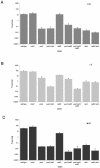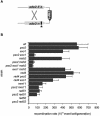DNA interstrand cross-link repair in the Saccharomyces cerevisiae cell cycle: overlapping roles for PSO2 (SNM1) with MutS factors and EXO1 during S phase
- PMID: 15743825
- PMCID: PMC1061624
- DOI: 10.1128/MCB.25.6.2297-2309.2005
DNA interstrand cross-link repair in the Saccharomyces cerevisiae cell cycle: overlapping roles for PSO2 (SNM1) with MutS factors and EXO1 during S phase
Abstract
Pso2/Snm1 is a member of the beta-CASP metallo-beta-lactamase family of proteins that include the V(D)J recombination factor Artemis. Saccharomyces cerevisiae pso2 mutants are specifically sensitive to agents that induce DNA interstrand cross-links (ICLs). Here we establish a novel overlapping function for PSO2 with MutS mismatch repair factors and the 5'-3' exonuclease Exo1 in the repair of DNA ICLs, which is confined to S phase. Our data demonstrate a requirement for NER and Pso2, or Exo1 and MutS factors, in the processing of ICLs, and this is required prior to the repair of ICL-induced DNA double-strand breaks (DSBs) that form during replication. Using a chromosomally integrated inverted-repeat substrate, we also show that loss of both pso2 and exo1/msh2 reduces spontaneous homologous recombination rates. Therefore, PSO2, EXO1, and MSH2 also appear to have overlapping roles in the processing of some forms of endogenous DNA damage that occur at an irreversibly collapsed replication fork. Significantly, our analysis of ICL repair in cells synchronized for each cell cycle phase has revealed that homologous recombination does not play a major role in the direct repair of ICLs, even in G2, when a suitable template is readily available. Rather, we propose that recombination is primarily involved in the repair of DSBs that arise from the collapse of replication forks at ICLs. These findings have led to considerable clarification of the complex genetic relationship between various ICL repair pathways.
Figures






References
-
- Bai, Y., and L. S. Symington. 1996. A Rad52 homolog is required for RAD51-independent mitotic recombination in Saccharomyces cerevisiae. Genes Dev. 10:2025-2037. - PubMed
-
- Beljanski, V., L. G. Marzilli, and P. W. Doetsch. 2004. DNA damage-processing pathways involved in the eukaryotic cellular response to anticancer DNA cross-linking drugs. Mol. Pharmacol. 65:1496-1506. - PubMed
-
- Bessho, T. 2003. Induction of DNA replication-mediated double strand breaks by psoralen DNA interstrand cross-links. J. Biol. Chem. 278:5250-5254. - PubMed
Publication types
MeSH terms
Substances
LinkOut - more resources
Full Text Sources
Molecular Biology Databases
